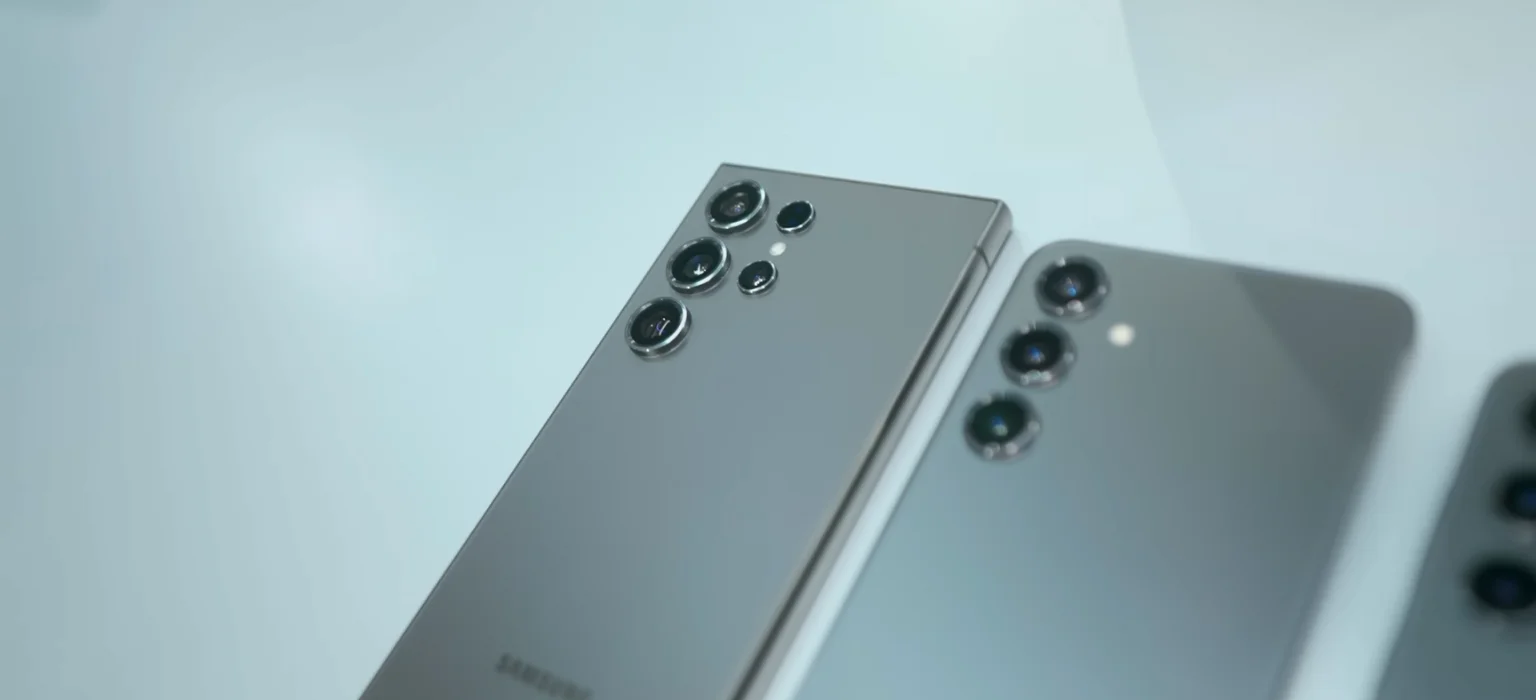
Samsung’s new Galaxy S24 lineup showcased at its recent Unpacked event felt practically indistinguishable from a Google Pixel launch. The entire presentation centered heavily on AI-driven software advancements aiming to deliver standout new convenience features. In many ways, Samsung’s phones now encapsulate the best parts of Pixel devices – but with the durability Google still fails to provide. However, a troubling fine print revelation hints Samsung could eventually gate formerly free functionalities behind paywalls post-2025.
Samsung Phones Quickly Closing Gap With Pixel Software Dominance
For years, Google Pixels remained top Android dog thanks largely to exclusive software capabilities like real-time translations, AI-powered messaging and seamless background processes to automatically enhance photos. But Samsung aims to nullify Pixel exclusivity across all these areas with its new Galaxy S24 lineup.
The S24 series matches Pixel features point-for-point in uncanny fashion. Live Translate, Magic Eraser, Cinematic Wallpapers and more all suddenly materialized in Samsung’s arsenal. This parity in software power between the rival phone makers means Samsung can now also match, or even surpass in some areas, the Pixel user experience that built Google’s reputation.
But when you factor in Samsung’s tendencies to utilize premium materials where Google cut corners, the hardware improvements become arguably even more impactful than matching AI capabilities. After all, flawless software means little on a fragile device prone to rapid decline.
Google Pixel Hardware Continues Failing Loyal Users

Despite the beloved fluidity of Pixel software when new, Google’s track record on durable device construction remains rightfully scrutinized. Across the Pixel 6, Pixel 7 and now Pixel 8 rollout, trusted tech reviewers report discouraging hardware issues degrading core functionality after relatively brief lifespans under two years.
My personal Pixel 6 began experiencing severe slowdowns and glitches a mere 14 months into ownership. Others report failing components like detaching volume buttons or unresponsive fingerprint sensors that should never malfunction so quickly at premium price points. Even pricier models like the $899 Pixel 7 Pro succumb frustratingly fast.
These reliability pitfalls tarnish the Pixel brand given owners invest substantial money upfront in expectation of enjoying several years of satisfactory service. When manufacturing flaws and deficiencies emerge nearly immediately, it’s hard not to feel shortchanged regardless of stunning camera capabilities or AI charm.
Many diehard Pixel fans cling to each launch solely for the polished software experience. But when devices start literally falling apart during normal use well ahead of the two-year mark, it’s impossible to ignore the ridiculous hardware gaps between Google and rivals like Samsung or Apple renowned for durability.
Samsung’s Premium Build Quality Finally Aligns With Top-Tier Software
The Pixel software Throne held by Google finally faces intense pressure in 2023 as Samsung steals countless beloved features straight from the Pixel playbook while asserting hardware advantages. This combination hypothetically renders Pixel devices borderline obsolete now that Samsung narrowed software gaps considerably.
No current Pixel exclusive remains unjustly absent from Galaxy S24 models. Meanwhile, no other Android competitor pairs flagship-caliber performance with luxury metallic frames, shatter-resistant Gorilla Glass Victus 2 and IP68 dust/water resistance ratings.
While tech pundits justifiably criticize many brands like OnePlus or Motorola for cutting corners, no such critiques hold weight against premium leaders like Samsung. Hardware, software and accessory support are truly uncompromised even by Apple’s lofty benchmarks.
Unless you demand a pure Android experience stripped of Samsung customizations, the S24 Ultra reasonably outmatches Google’s current spec-for-spec in nearly all areas. And the two brands offer enough software similarities currently where preference splits between personal tastes more than exclusive advantages holding sway.
For Pixel loyalists like myself weary of poor construction, Samsung now presents extremely compelling solutions matching beloved Google functionality. Had they not tipped their hand already on eventually monetizing elements post-2025 however, the choice would become almost inarguable.
Samsung AI Features Set To Switch From Free to Fee After 2025
Just as Samsung managed to analyzed years of Pixel feature gaps and essentially nullify Google’s exclusive corner on the software experience, an alarming revelation hints the company plans eventually charging for access. This greatly changes the value proposition conversation just as Galaxy devices closed in on Pixel’s appeal.
A recently unearthed disclaimer from Samsung’s Australian site explains the company will only provide complimentary access to its newly touted Galaxy AI features until December 31, 2025. So all the beloved Pixel-inspired offerings like automatic photo editing, video highlighting and enhanced messaging could default back to locked status three years from now.
The only exclusions from this provision are third-party AI integrations like Google’s Circle app providing contextual notifications from device actions. But Samsung’s proprietary automation tools revealed as selling points during its Unpacked event do face impending restrictions without paying yet-unannounced fees.
While free access extending through 2025 gives Samsung ample opportunity to hook users on its AI conveniences before reintroducing barriers, this bait-and-switch approach may spur backlash. Google for example never locked previously free Pixel functionalities behind paywalls later on. So Samsung risks appearing excessively greedy should they follow through charging down the road.
Will Samsung Actually Charge for AI Features After 2025?
While Samsung’s disclaimer language around eventually monetizing helpful AI tools does seem unambiguous on paper, reasonable doubts exist on whether the company would ever truly upset customers with such a drastic reversed course.
After all, the disclaimer largely covers the company legally should it elect to take that unpopular path. But transitioning complimentary features to carrying fees risks immense damage to brand loyalty and satisfaction. So the odds of Samsung actually choosing financial upside over customer sentiment seems unlikely.
The safer assumption is this controversial clause simply allows flexibility to charge modest fees IF advanced new functionalities later justify added costs. But foundational automations like Photo Editor, Video Highlighter and Interpreter Mode not central to Samsung’s forthcoming revenues hardly seem plausible candidates for future paywalls in reality.
Samsung surely recognizes what a disastrous PR crisis instantly charging for widely embraced offerings overnight would cause. Any hidden recurring revenues would need introducing gradually and stealthily to avoid mass cancellations from outraged Galaxy device families.
For now, buyers can reasonably bank on the current slate of AI features shipping with Galaxy S24 models remaining forever free barring unforeseen circumstances down the road. But the seeds for monetization DO appear planted should financial allure eventually outweigh protecting customer satisfaction years later.
Google Still Offers Some Standout Exclusives, But Gaps Keep Closing
Given Samsung’s immense 2023 progress nullifying countless Pixel software differentiators, it’s fair to wonder if any compelling reasons still favor Google’s struggling premium phones today. The answer is yes at least for now. But Google must keep innovating quickly to protect its increasingly narrow path towards hardware profitability.
Arguably the Pixel 8 Pro’s last stronghold currently is its best-in-class camera system marrying hardware and computational photography algorithms remarkably. Samsung took huge strides closing imaging quality gaps with the S23 series, but Pixel phones capture nuanced lighting, color richness and subject isolation better pound-for-pound.
Google also provides certain exclusive editing tools like Magic Eraser and Photo Unblur which often outperform Samsung’s alternatives going head-to-head. And the unified Google ecosystem integrations foundational to Pixel experience still cater better towards users already embedded among other Google services. Samsung splits focus between its own apps and third parties.
But Samsung counterpunches camera advantages by offering unmatched zoom functionality. And Google apps can still run perfectly fine on Galaxy devices even if Samsung services sometimes feel slightly preferred. For most intents and purposes, the user experiences grew remarkably comparable now at both software and hardware levels.
With Samsung matching must-have Pixel traits across translations, AI photo handling, messaging, video and more, Google can no longer rest on exclusive app capabilities alone to justify significant hardware cost gaps. Deeper operating system integrations must emerge fast to widen gaps before Samsung duplicates those too.
Samsung’s Strategy Could Foreshadow More Brands Charging Later On
While scope remains limited currently to gauge exactly how Samsung plans harnessing AI features financially long-term, early signs are telling for broader industry trajectories as well. As multiple brands increasingly tout their own proprietary automation tools in a bid to mimic Pixel success, eventual monetization schemes likely spread across the Android landscape.
Huawei, Xiaomi, Oppo and more jumped firmly on the AI bandwagon lately too. And if Samsung establishes precedent where flagship buyers organically accept recurring fees after brief honeymoon periods of free access, expect rivals to quickly follow suit. A troubling trend could emerge where Android buyers unwittingly aid financing advanced AI development costs after already paying premium prices for devices upfront.
Unlike Apple which primarily monetizes services like iCloud storage or Apple Music, Android device makers rely almost wholly on hardware sales to subsidize operations. So the economically challenged reality of high manufacturing costs, thin profit margins and intense competition leaves companies seeking creative new subscription opportunities however possible.
Unfortunately, much like airlines now charging for every perk and convenience once free historically, phone makers seem poised to let alluring AI capabilities seduce users first before eventually holding desired functionality hostage. And since early capabilities unlocked by device purchases lay core groundwork nurturing reliance on automation conveniences, later withdrawing access risks significant backlash.
For now, buyers evaluate Galaxy S24 phones using today
Read More :-
